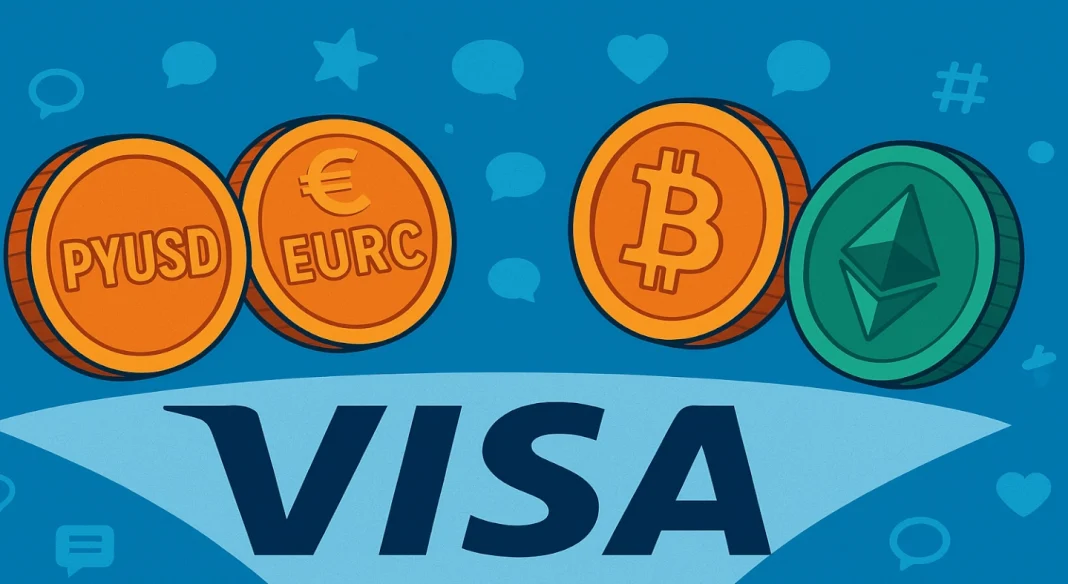Visa just dropped a major crypto-related move. You thought they were just about plastic cards and swipes? Forget that, the company’s marching onto crypto fields, and it’s getting serious.
They’re expanding their crypto settlement platform, bringing new heavy hitters to the table like PayPal USD, Global Dollar, and Circle’s euro-backed EURC.
And if that wasn’t enough, Visa’s now buddying up with Stellar and Avalanche blockchains.
Cross-border deals
Now, let’s rewind a bit. Visa’s crypto settlement world used to be a simple neighborhood, Ethereum and Solana only.
Not anymore! With Stellar and Avalanche joining the crew, these developers and partners have a bigger, shinier sandbox to play in.
This move boosts Visa’s standing in the booming stablecoin economy big time, think of it as expanding their real estate in an already hot neighborhood.
Visa’s friendship with Paxos is bringing PYUSD and USDG into the mix, both are U.S. dollar-backed stablecoins gaining ground fast in real-world use.
And the new kid on the block, EURC, a euro-pegged stablecoin from Circle, throws Europe into the spotlight.
For businesses juggling international payments, having both dollar and euro stablecoins at their fingertips is like getting a VIP pass for cross-border deals.
Beyond settlements
Rubail Birwadker, Visa’s Global Head of Growth Products and Strategic Partnerships, puts it straight, and says Visa isn’t just about sticking to one coin or chain.
Now they want a multi-coin, multi-chain kingdom where stablecoins flow freely, securely, and scalably.
This latest step makes room for four different stablecoins and four blockchains all shaking hands on Visa’s platform.
And if this isn’t enough, Visa’s been ramping up its game beyond settlements. Earlier this year, they extended stablecoin-linked card programs, letting wallets connect seamlessly with payment cards working across multiple blockchains.
Imagine paying with crypto as easy as swiping your card at the Grocery Joe’s, faster and cheaper for cross-border or on-chain transfers. No wonder fintech developers and merchants are buzzing.
Building the infrastructure
By mid-2025, Visa wasn’t stopping at the usual suspects. They expanded stablecoin offerings in Central and Eastern Europe, the Middle East, and Africa, teaming up with Yellow Card, a crypto leader in Africa.
The goal? Smoother, more efficient payments across borders and lifting developing markets into the future.
Looking ahead, Visa’s got plans to add even more stablecoins and blockchain tech, building the kind of scalable infrastructure that rivals traditional card payments in reliability and speed.
As crypto assets gain trust and practical use, it seems Visa wants to be the kingpin making crypto payments feel just as safe as handing over cash.
Frequently Asked Questions (FAQ)
What stablecoins did Visa add to its settlement platform?
Visa integrated four stablecoins into its crypto settlement platform: PayPal USD (PYUSD), Global Dollar (USDG), Circle’s euro-backed EURC, and existing ones like USDC. These additions improve payment flexibility for cross-border transactions.
Which blockchains are now supported by Visa?
Visa now supports four blockchains: Ethereum, Solana, Stellar, and Avalanche. This multi-chain expansion boosts scalability, speed, and global accessibility.
How does this benefit international payments?
Businesses can now settle in both U.S. dollar and euro stablecoins, making cross-border payments faster, cheaper, and more reliable. This move also improves financial access in developing regions like Africa and the Middle East.
Disclosure:This article does not contain investment advice or recommendations. Every investment and trading move involves risk, and readers should conduct their own research when making a decision.
Kriptoworld.com accepts no liability for any errors in the articles or for any financial loss resulting from incorrect information.
Cryptocurrency and Web3 expert, founder of Kriptoworld
LinkedIn | X (Twitter) | More articles
With years of experience covering the blockchain space, András delivers insightful reporting on DeFi, tokenization, altcoins, and crypto regulations shaping the digital economy.
📅 Published: August 2, 2025 • 🕓 Last updated: August 2, 2025
✉️ Contact: [email protected]


